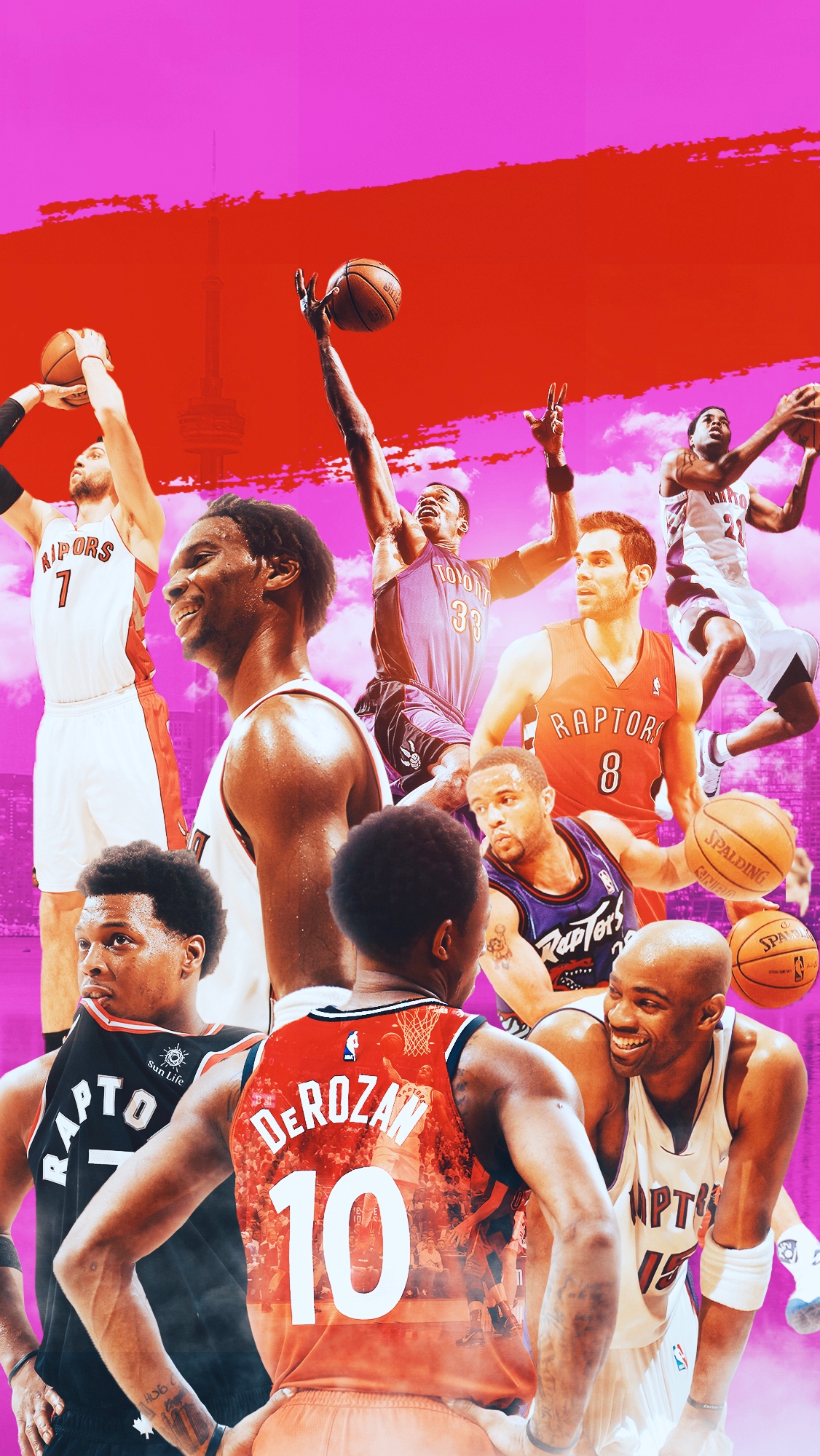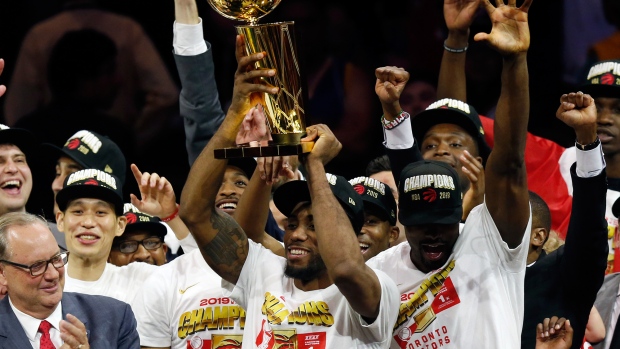

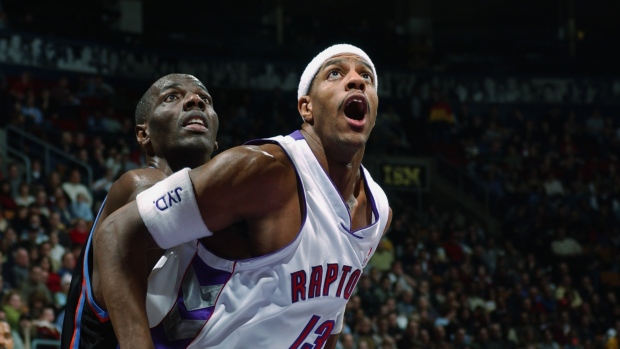

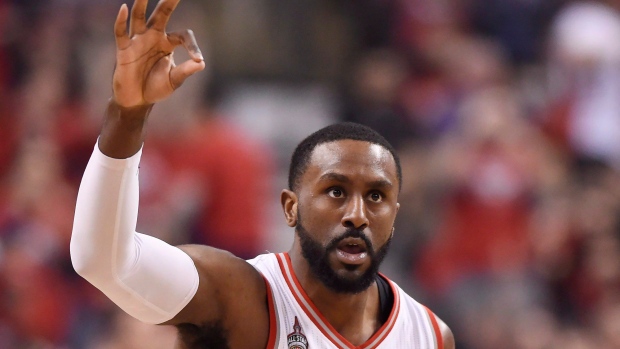
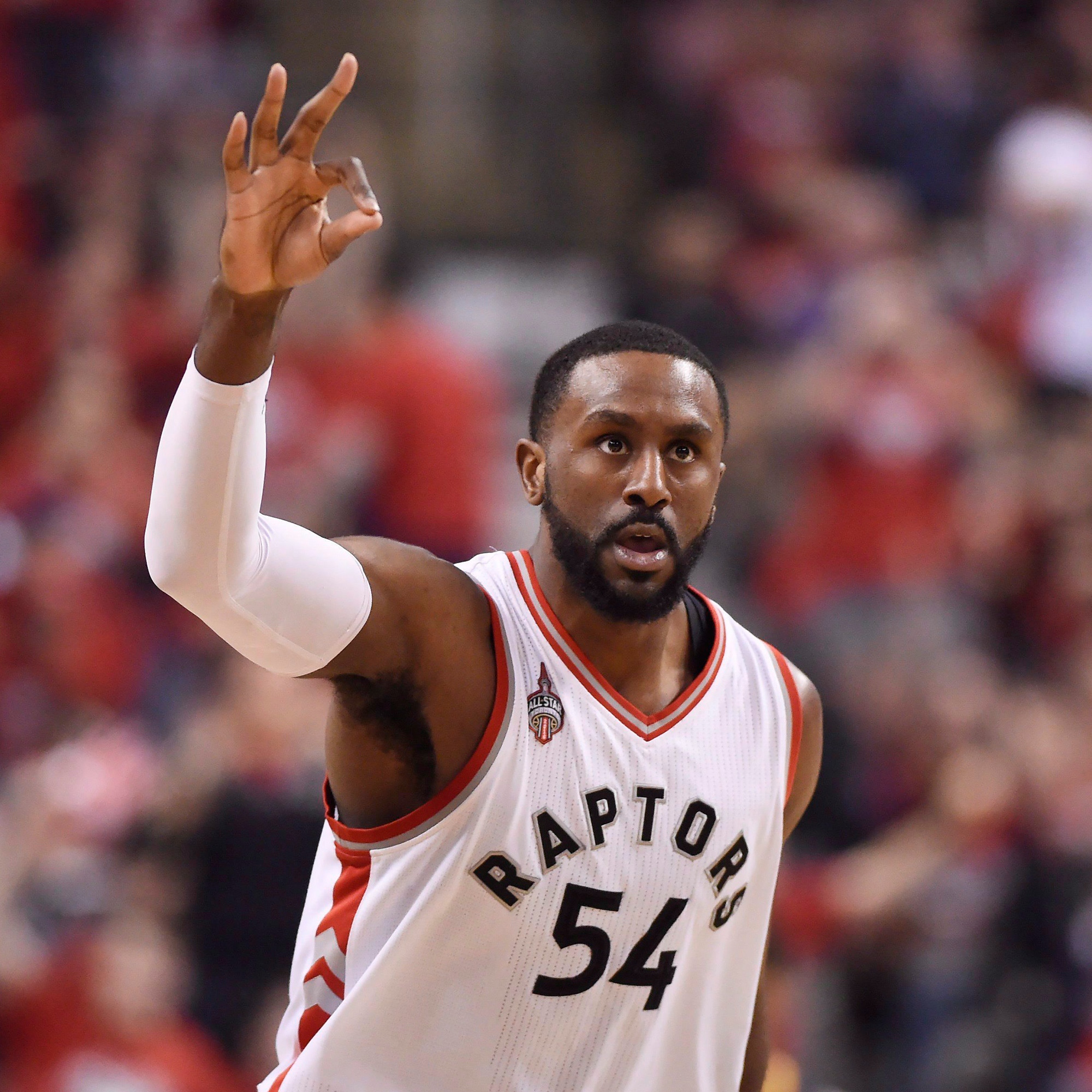
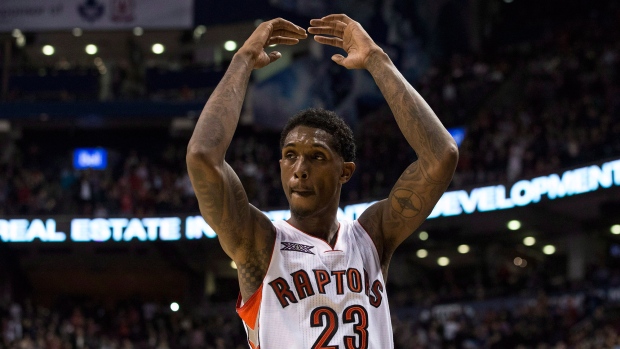
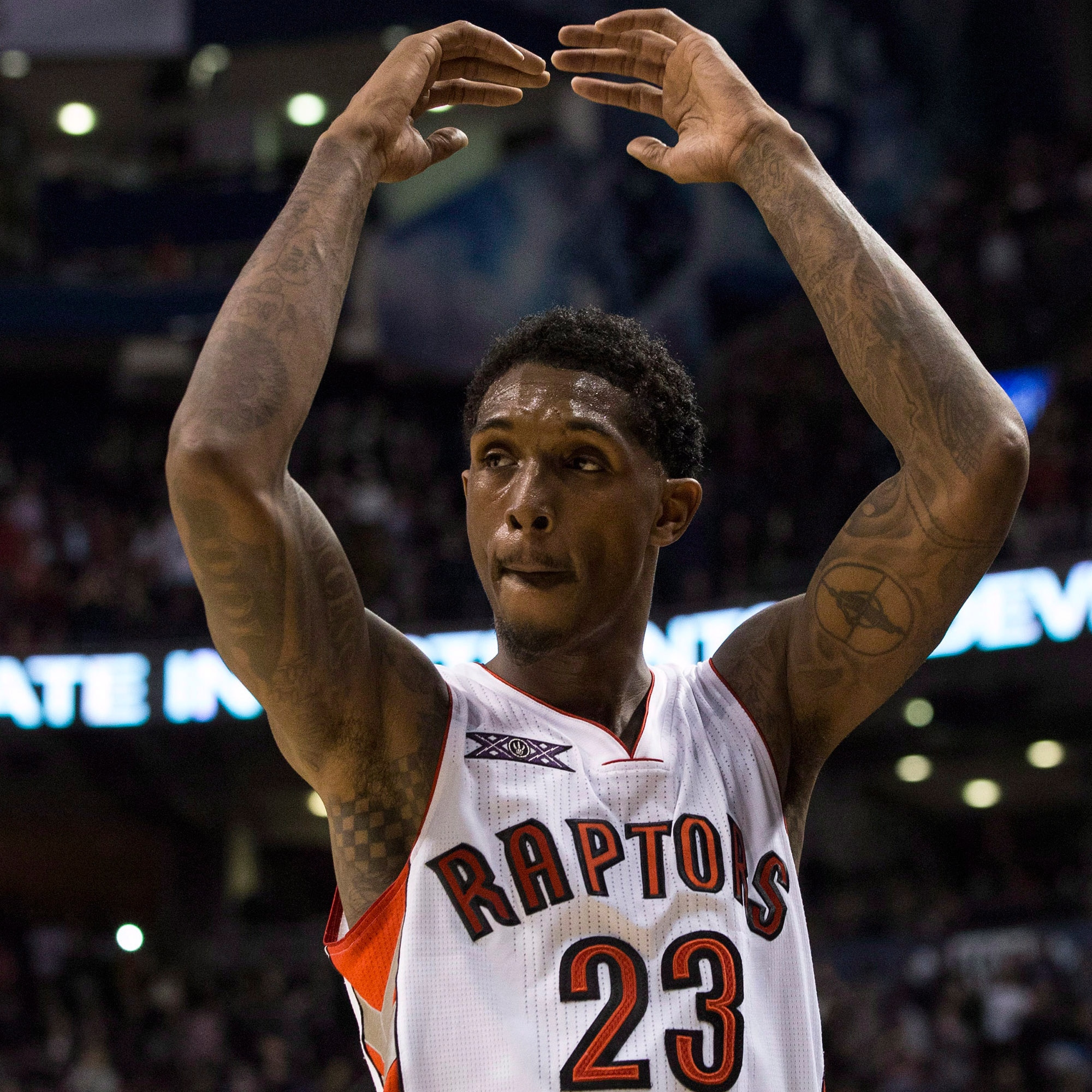




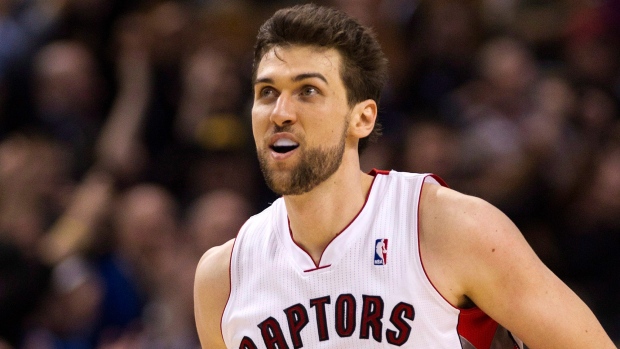
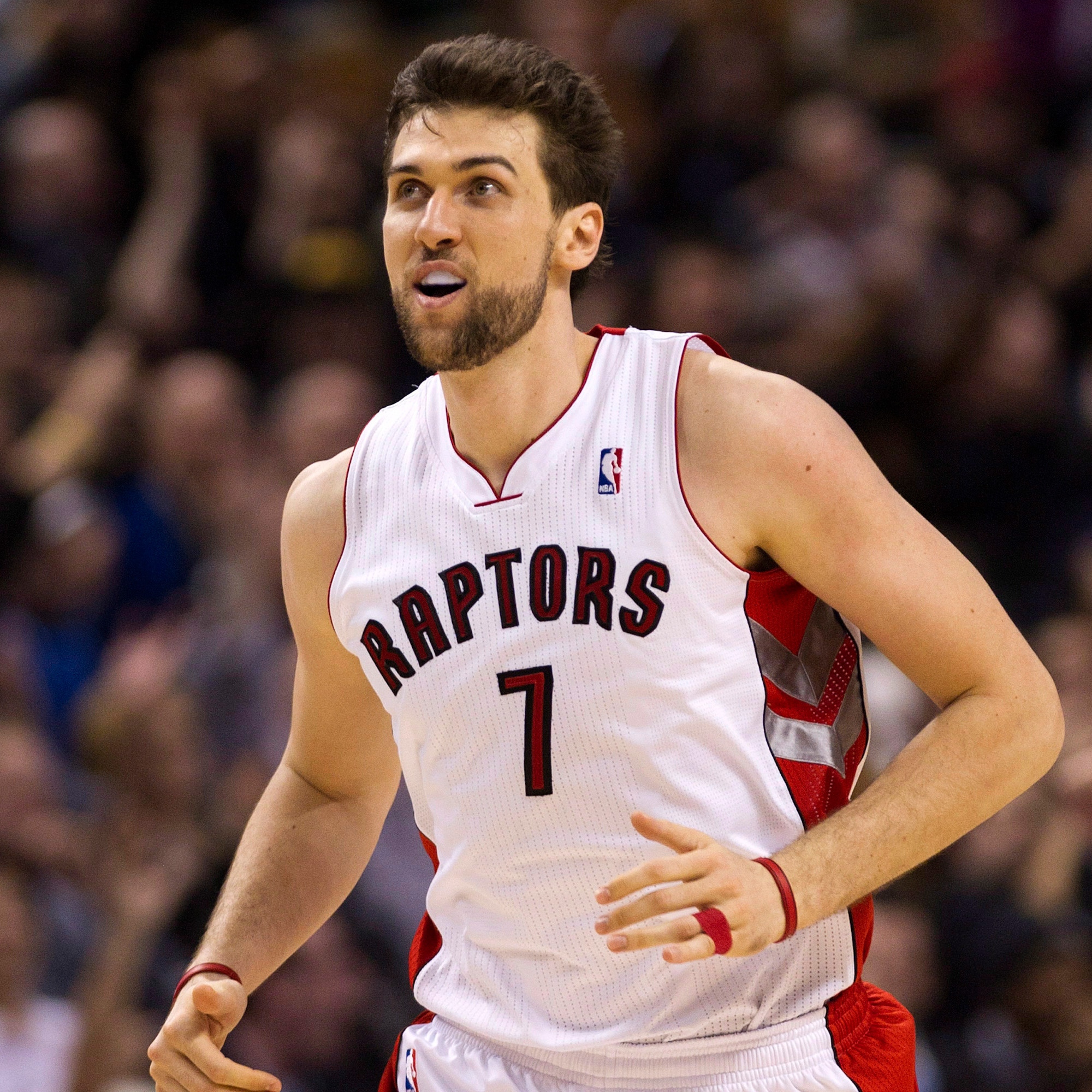




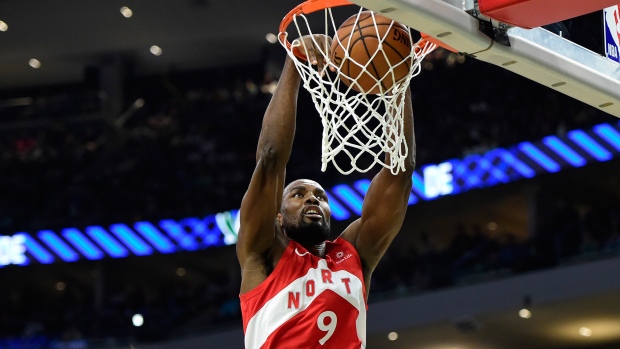

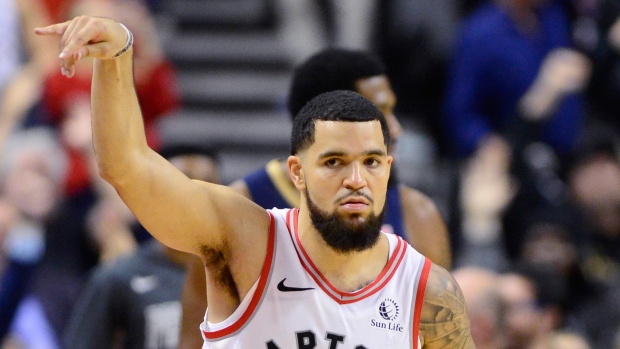
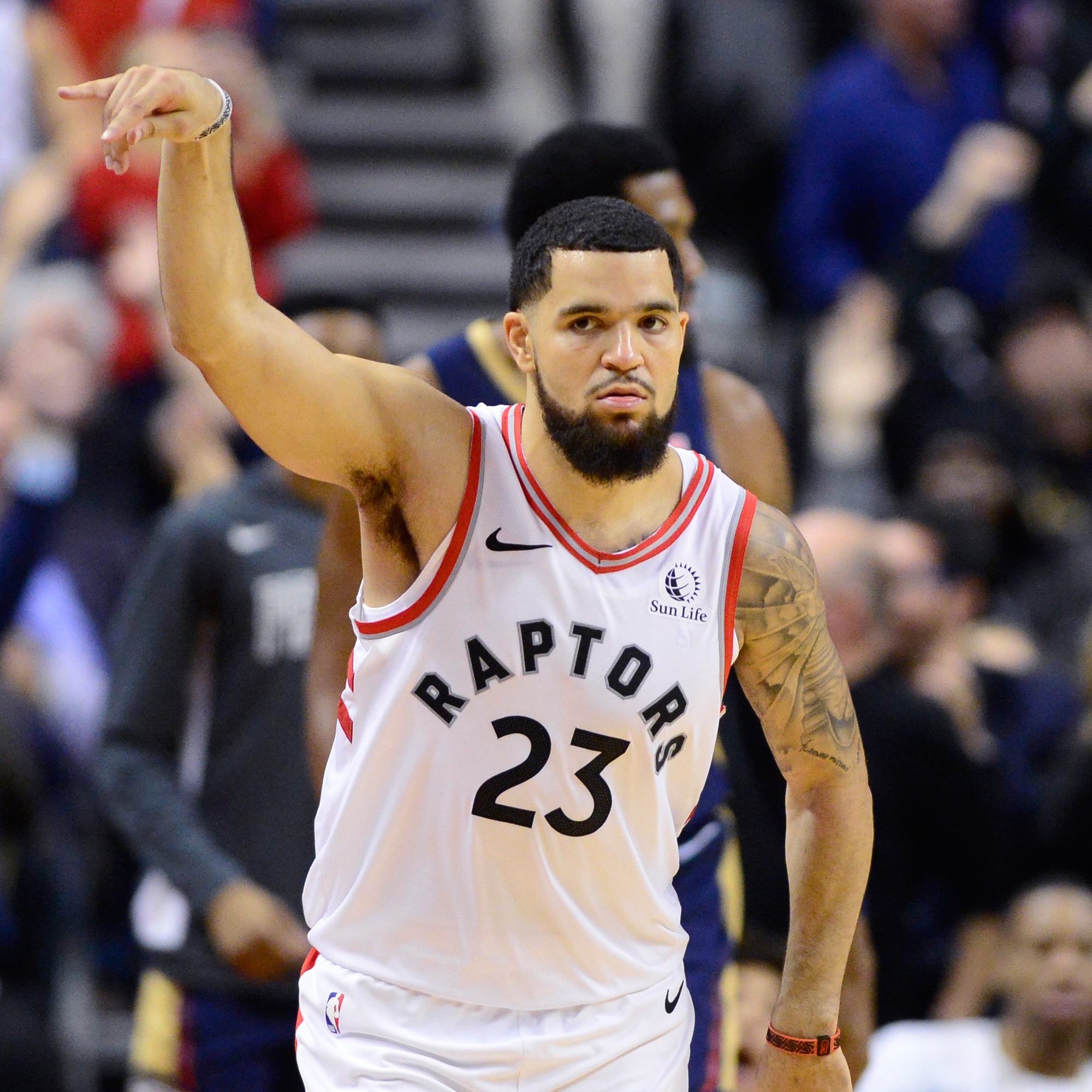
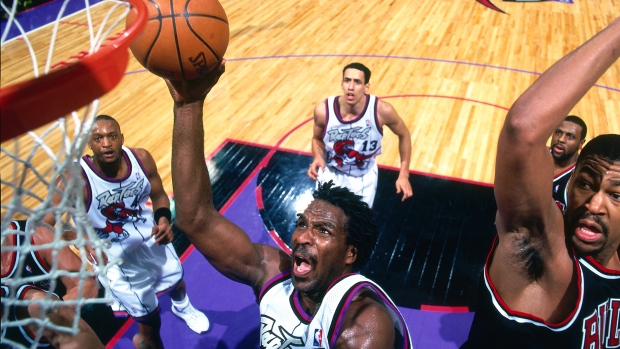



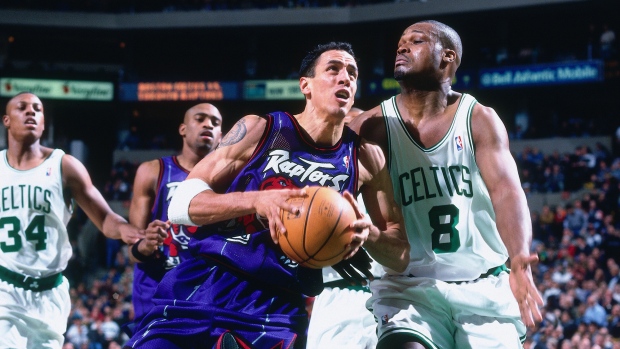

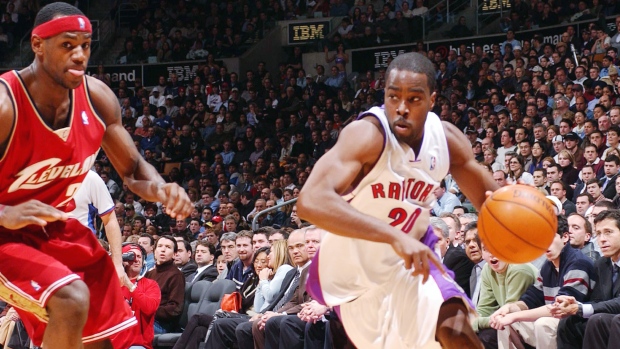


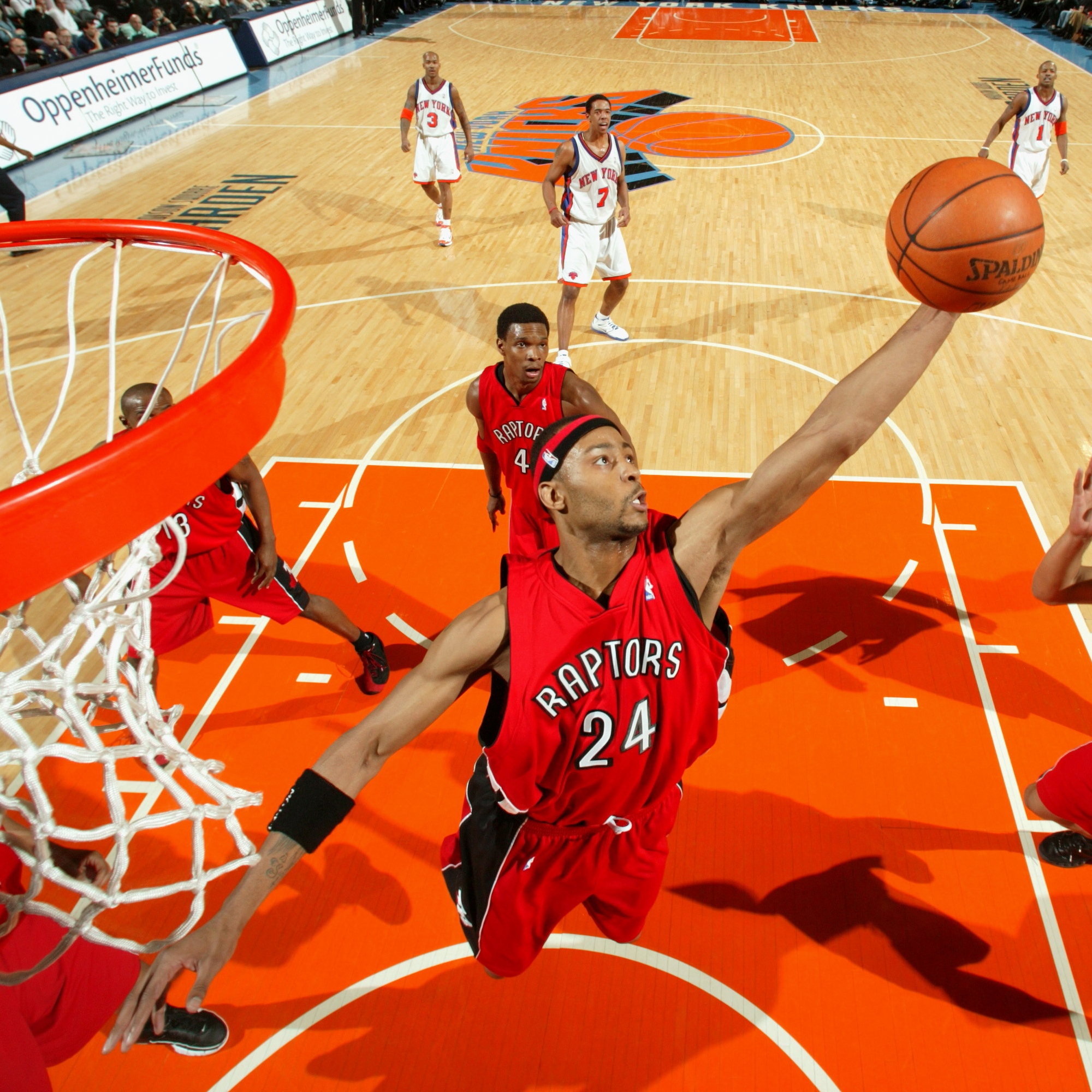
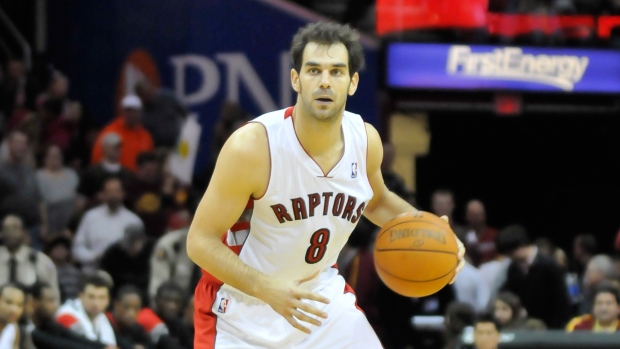

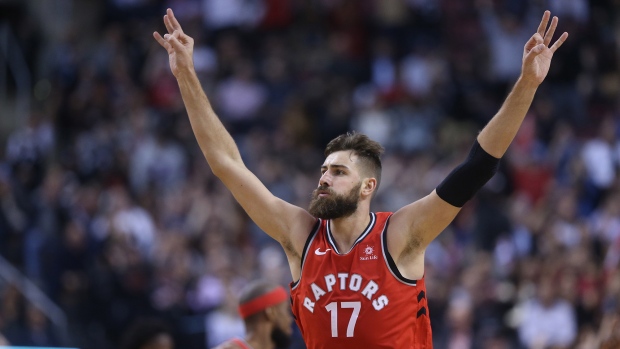
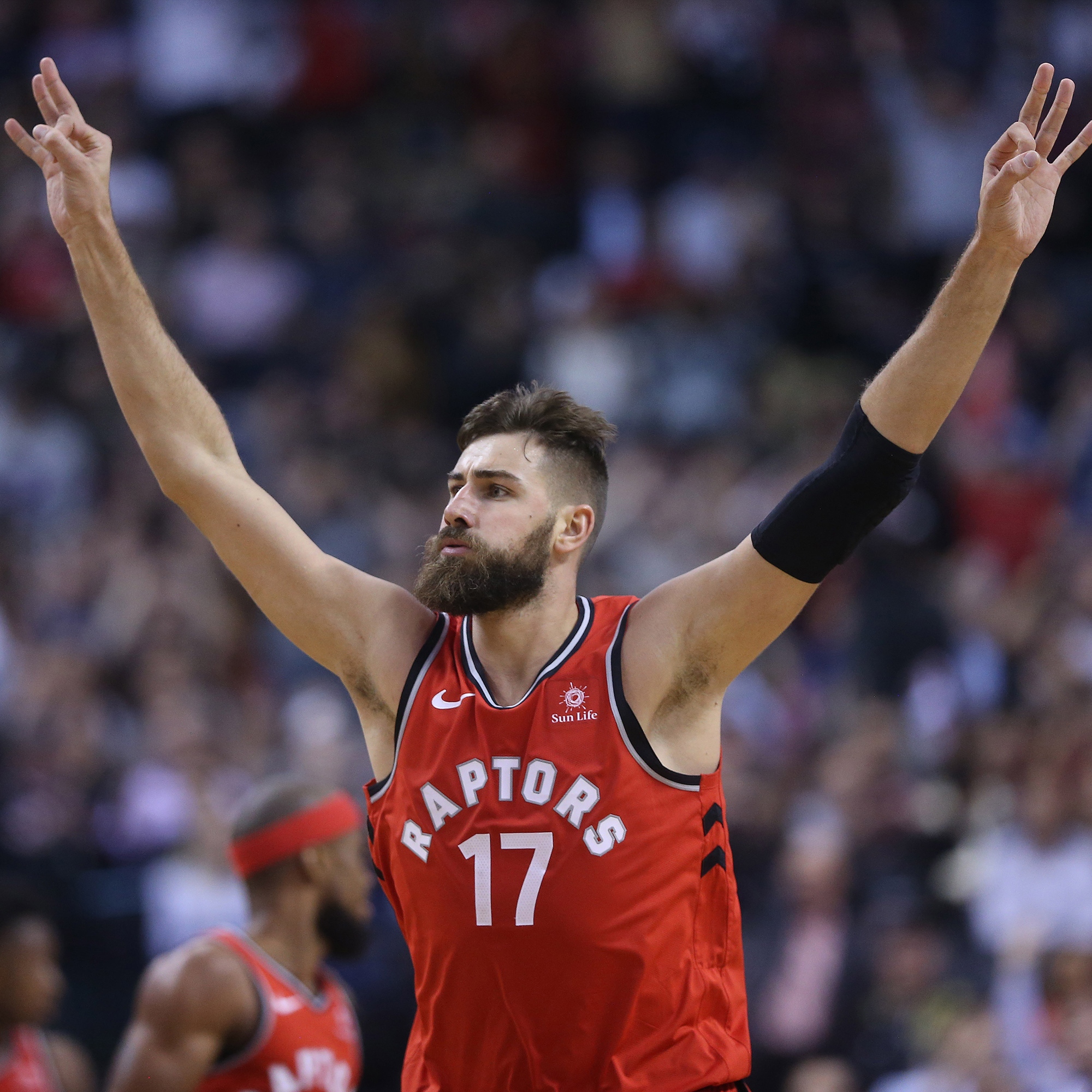

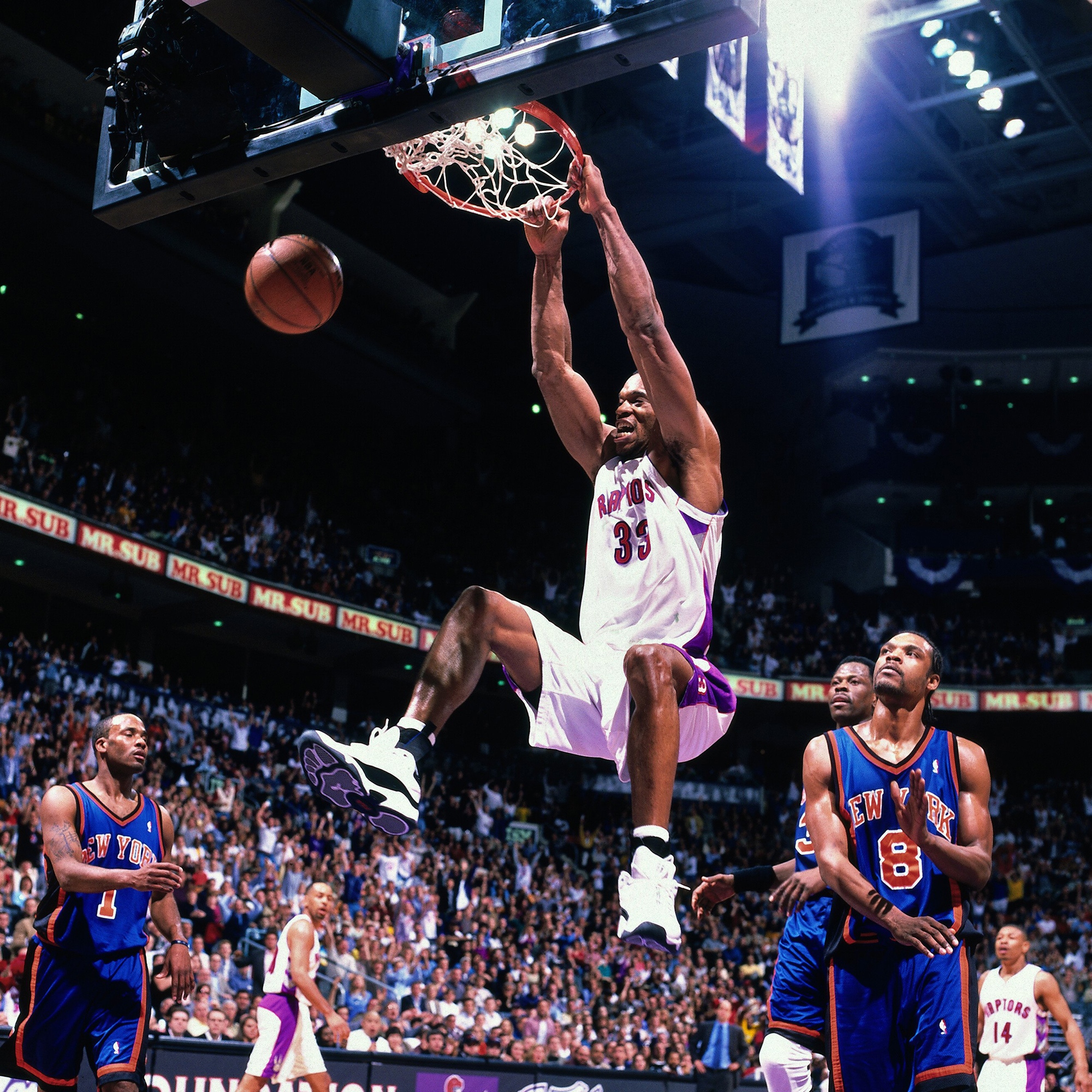


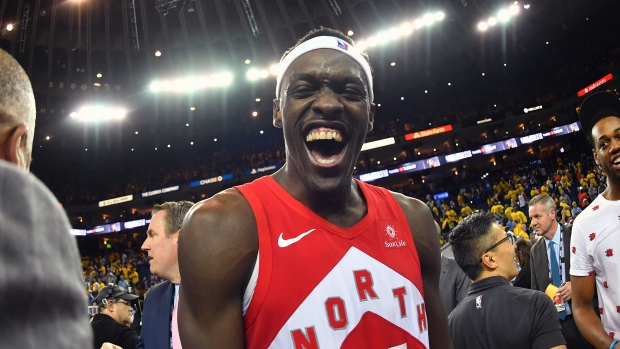

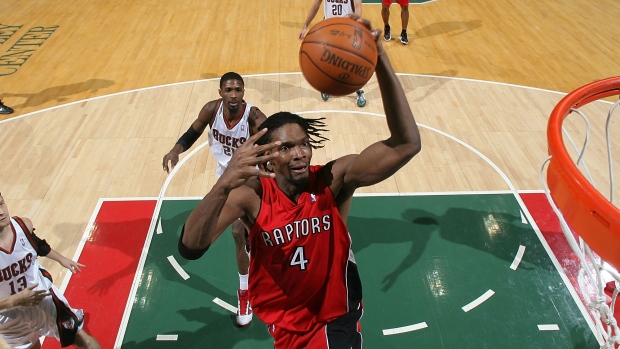

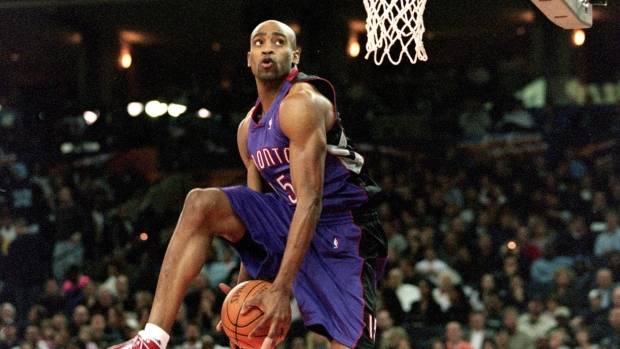

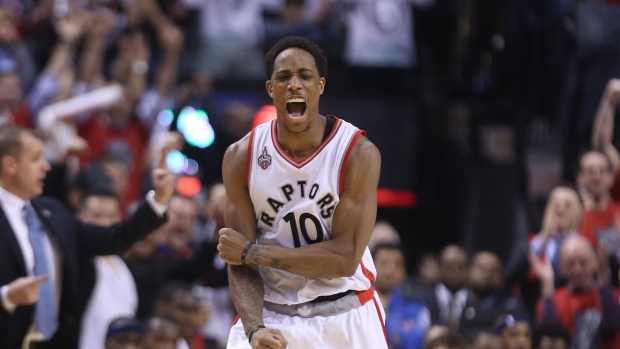

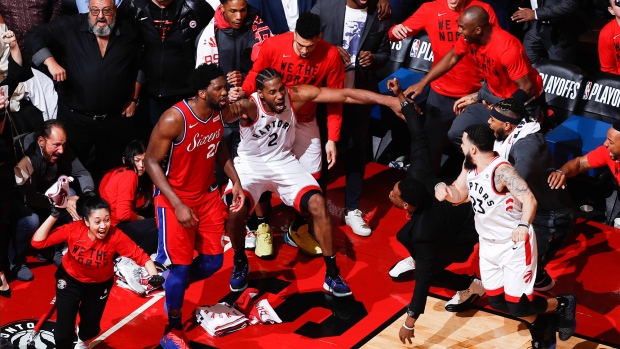
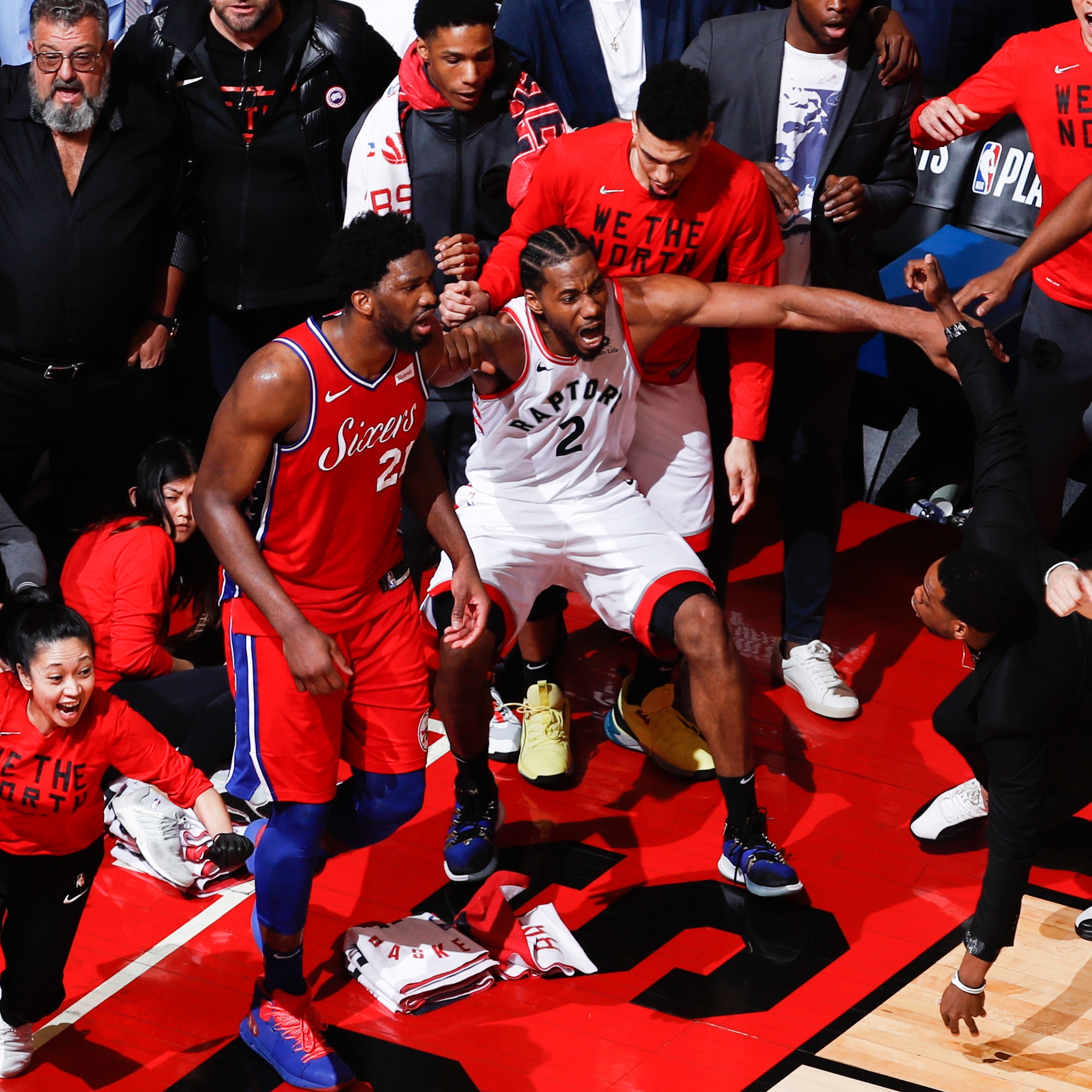
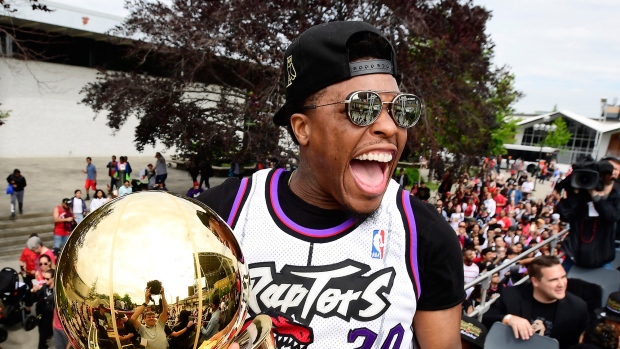




This is an especially nostalgic time for the Toronto Raptors. Not only are they the defending NBA champions, but they’re also celebrating their 25th-anniversary season.
In addition to wearing their throwback pinstripe jerseys and playing on a specially designed retro court on select nights throughout the year – beginning Oct. 28 against Orlando and including Kawhi Leonard’s highly anticipated return with the Clippers on Dec. 11 – they’ll be taking a look back at the franchise’s first quarter century in the league.
From a 16-win campaign playing inside the cavernous SkyDome early in their existence to this recent and most successful generation – the We the North era, culminating in last year’s improbable title run – it’s been a ride: three different home arenas, six general managers, nine coaches and more than 230 players.
As the Raptors spend the season paying homage to their first 25 years, TSN’s Josh Lewenberg will count down the 25 greatest players in team history.
The criteria: Only a player’s time in Toronto was considered – nothing before or after (Sorry, Hakeem Olajuwon). The players were evaluated, scored and ultimately ranked based on four primary categories – longevity, individual success, contribution to team success and lasting impact on the organization, city and fan base. This is obviously a subjective exercise.
Photo courtesy: Getty Images

25. Jerome Williams
SF/PF - 6'9, 206 lbs.
Raptor from 2000-01 to 2003-04
Toronto Career Stats: 180 GP, 7.9 PPG, 7.0 RPG, 1.1 APG
Best known as the Junk Yard Dog (the original, 1.0), Williams meant – and still means – more to the organization than his numbers would indicate.
Acquired from Detroit at the 2001 trade deadline, he quickly became an important part of Lenny Wilkens’ rotation, bringing energy and toughness off the bench for a team that won its first ever playoff series and fell one shot short of advancing to the East Finals.
A year later, with Carter hurt and their playoff hopes fading, Williams stepped into the starting lineup and – along with Antonio Davis and Alvin Williams – played a crucial role as Toronto won 12 of its last 14 games to squeeze into the postseason, where they nearly upset the second-seeded Pistons (if only Chris Childs knew the score).
JYD was an instant fan favourite for his relentless style of play and trademark intensity, but he was more than just a high-energy cheerleader. Williams goes down as one of the best defenders and rebounders to play for the franchise. To this day, he still ranks seventh in rebounds per game and is fourth in defensive rating.
One of the most beloved Raptors ever, he remains a great ambassador for the team and for basketball in Canada. In addition to his impact on the court, which was greater than most remember, that should count for something.
Super stat: Williams ranks second on the Raptors’ all-time steal percentage list, only behind Doug Christie. He averaged 1.3 steals per game with Toronto, tied with Carter for fifth-most in franchise history.
Fun fact: Immediately after being traded to the Raptors on Feb. 22, 2001, Williams famously jumped in his truck and drove from Detroit to Toronto.
Photo courtesy: Ron Turenne, Getty Images

24. Patrick Patterson
PF - 6'9, 230 lbs.
Raptor from 2013-14 to 2016-17
Toronto Career Stats: 273 GP, 7.6 PPG, 4.8 RPG, 1.4 APG
Similar to Williams, Patterson’s impact and importance transcended the box score. His stats won’t jump off the page, they never did, but he makes this list for his role in turning the organization’s fortunes and propping up some of the best teams in franchise history.
He came to Toronto as part of the seven-player deal that sent Rudy Gay to Sacramento and was supposed to be the first step in tearing things down. Instead, it inadvertently sparked the Raptors renaissance. Of course, that doesn’t happen without Lowry and DeRozan blossoming into stars, a by-product of the trade, but the four players coming back – Patterson, Greivis Vasquez, John Salmons and Chuck Hayes – were factors in their own right, and none more than Patterson.
Patterson was the quintessential glue guy – a smart, versatile player who could do everything well on both ends of the floor and made his teammates better. He was a key member of some great second units, closed games with the starters and almost always elevated the lineups he played with.
Dwane Casey always believed he was better suited coming off the bench, although his sample size as a starter was very small, so he may have been underutilized and even a bit underappreciated in his role. He was a reluctant shooter at times and a nagging knee injury slowed him in his final year with Toronto. Still, his fingerprints are all over the Raptors turnaround.
Super stat: In Patterson’s four seasons with Toronto, the Raptors were plus-1,201 with him on the court and plus-44 with him off it.
Fun fact: Patterson found out he was traded to Toronto just before going into the theatre to see The Hunger Games with his mom. They watched the movie and he told her the news afterwards. “I couldn’t let it ruin the movie.”
Photo courtesy: Frank Gunn, Canadian Press

23. Lou Williams
G - 6'1, 175 lbs.
Raptor for the 2014-15 season
Toronto Career Stats: 80 GP, 15.5 PPG, 1.9 RPG, 2.1 APG
Williams is one of only three single-season Raptors to crack this list. He didn’t grade well in the longevity category, obviously, but his lone season in Toronto was so memorable that Drake made a track about it.
The Raptors got Williams for nothing, essentially (the non-guaranteed contract of John Salmons). He was coming off an injury and Atlanta was happy to unload his salary. He would go on to resurrect his career in Toronto, en route to winning his first of three (and counting) Sixth Man of the Year awards.
He’s not exactly the most well-rounded player. Fair or not, he was scapegoated for the team’s defensive regression late in the season and into the playoffs, where they were swept by Washington, and wasn’t even offered a contract as a free agent that summer. Say what you will about his work on that end of the floor, but man, he could score.
His end-of-quarter ISOs, deadly pump fake and knack for drawing fouls, or his crafty floater in the lane – the Lou Will experience was a fun one.
Super stat: The 49-win 2014-15 Raptors outscored opponents by a team-best 298 points with Williams on the court. They were outscored by 46 points with him off it.
Super stat 2: Williams was fifth in the NBA in fourth-quarter scoring that season, behind Damian Lillard, LeBron James, James Harden and Isaiah Thomas.
Photo courtesy: Chris Young, Canadian Press

22. Donyell Marshall
PF/SF - 6'9, 218 lbs.
Raptor from 2003-04 to 2004-05
Toronto Career Stats: 131 GP, 13.8 PPG, 8.7 RPG, 1.3 APG
Marshall wasn’t in Toronto long and the Raptors weren’t very good while he was around. What separates him from players in similar situations that didn’t make the list – Mike James and teammate Jalen Rose, among others – is just how good, efficient and valuable he was during his tenure.
In many ways he was ahead of his time – a mobile big man who could shoot the lights out and defend multiple positions. Imagine how valuable he would be if he played today.
Marshall shot 41 per cent from beyond the arc on 5.0 three-point attempts per game as a Raptor, while also averaging a steal and a block.
His most memorable moment in Raptors uniform came against the 76ers on March 13, 2005. In 28 minutes off the bench, Marshall hit 12 of his 19 three-point attempts, tying Kobe Bryant’s record for most threes made in a game. That record stood until Steph Curry broke it in 2016 when he hit 13 threes. His Warriors teammate Klay Thompson topped it again a couple years later and holds the current record with 14.
Super stat(s): Despite his brief tenure, Marshall is still all over the Raptors leaderboard. He’s seventh in three-point percentage, third in rebounds per game behind Chris Bosh and Antonio Davis, second in defensive rating behind Keon Clark, fourth in player efficiency rating behind Vince Carter, Bosh and Kyle Lowry, and first in win shares per 48 minutes.
Photo courtesy: Getty Images

21. Tracy McGrady
SF/SG - 6'8, 210 lbs.
Raptor from 1997-98 to 1999-00
Toronto Career Stats: 192 GP, 11.1 PPG, 5.5 RPG, 2.5 APG
This seems like a good time to remind you that these rankings are only based on the each player’s Raptors tenure. Before he was a Hall of Famer, before he was a scoring champion, even before he was an all-star, McGrady was a gangly teenager playing in Toronto. Although he wasn’t playing nearly as much as he should have, which probably helped push him out the door.
The Raptors drafted him straight out of high school with the ninth-overall pick in 1997. As an 18-year-old rookie he played just 18 minutes a night. It wasn’t until his third year in the league – and his last in Toronto – that he became an important part of the rotation, mostly as the team’s sixth man.
McGrady averaged 15.4 points, 6.3 rebounds, 3.3 assists, 1.1 steals and 1.9 blocks in 31 minutes per game in 1999-00, and the Raptors made the playoffs for the first time in franchise history, where they would get swept by New York in the opening round.
Even early on you could see glimpses of superstardom. By the time he was getting real playing time, next to his cousin and fellow rising star Vince Carter, you knew he was going to be special. Alas, wasn’t thrilled about sharing the spotlight with Carter and wanted to play at home in Orlando.
Ah, what could have been.
Super stat: McGrady is tied for third in Raptors history in blocks per game (1.4). He’s the only guard in the top 10.
Photo courtesy: Fernando Medina, Getty Images

20. Andrea Bargnani
C/PF - 7'0, 245 lbs.
Raptor from 2006-07 to 2012-13
Toronto Career Stats: 433 GP, 15.2 PPG, 4.8 RPG, 1.3 APG
As polarizing a player as you’ll find on this list, Bargnani didn’t exactly endear himself to Raptors fans in his seven seasons with the team. For many people, the highlight of his tenure was the day Masai Ujiri swindled the Knicks into giving up a first-round pick for him.
He’s become something of a punch line for his Primo Pasta ads and uninspired effort, but Bargnani was actually a fine player before things went south in his last couple seasons. He played a lot of games and scored a lot of points for the Raptors. The biggest problem: he was miscast from day one.
General manager Bryan Colangelo made him the first-overall pick in 2006 – a defensible selection in a weak draft year, given his skill set and upside – but he never came close to living up to those expectations.
Then he became the de facto face of the franchise after Bosh left, a role he wasn’t suited for and didn’t even seem to want. All these years later, the only thing he’s the face of is one of the darkest eras in franchise history.
An early retirement from basketball speaks to what most people suspected for the bulk of his career: he just wasn’t that committed to the game. That was his real sin. It’s not that he wasn’t good. It’s that he wasn’t nearly as good as he should have been.
Super stat: Only four players have scored more points than Bargnani in a Raptors uniform – DeMar DeRozan, Bosh, Carter and Lowry.
Super stat 2: Bargnani, the Raptors’ former No. 7, averaged fewer rebounds (4.8) with the team than its current No. 7, Lowry (4.9), who’s a full foot shorter.
Photo courtesy: Getty Images

19. Danny Green
SG - 6'6, 215 lbs.
Raptor for the 2018-19 season
Toronto Career Stats: 80 GP, 10.3 PPG, 4.0 RPG, 45.5% 3PT
Green, the second one-year Raptor on this list, didn’t need more than a single season to make his lasting impact on the franchise.
The self-proclaimed “other guy” in the Kawhi Leonard trade, Green proved to be an essential piece to last season’s championship puzzle. As reliable as they come, he was the perfect fit in a low-usage, yet crucial role next to Leonard, Lowry and Pascal Siakam.
Green appeared in a team-high 80 games during the regular season, played consistently great defence – often guarding the opponent’s best perimeter player in an effort to lighten Leonard’s workload – and was one of the league’s very best three-point shooters. You could certainly argue that he’s the best three-point shooter in Raptors history.
He shot a remarkable 46 per cent from long range last year – the second-best single-season mark behind Jason Kapono, who hit 48 per cent of his threes in 2007-08. However, Green did it on 435 attempts – 317 more than Kapono.
Although his hope was to return as a free agent this summer and try to run it back, Green’s future in Toronto was always going to be tied to Leonard’s. Still, he was a great teammate and veteran leader, a fan favourite for the way he embraced the city and community, and an NBA champion.
Super stat: Of the 64 NBA players who attempted at least five three-pointers per game last season, only one – Brooklyn’s Joe Harris – shot a better percentage (47 per cent on 5.1 attempts) than Green (46 per cent on 5.4 attempts). Only one player – former Raptor P.J. Tucker – made more corner threes (109) than Green (93).
Photo courtesy: Getty Images

18. Anthony Parker
SG/SF - 6'6, 215 lbs.
Raptor from 2006-07 to 2008-09
Toronto Career Stats: 235 GP, 11.9 PPG, 4.0 RPG, 2.6 APG
An underrated Raptor, Parker was Danny Green before Danny Green.
He was reliable – playing 235 of a possible 246 games over his three seasons in Toronto – and could do a bit of everything on both ends of the floor. He was an excellent perimeter defender and shot the three-ball at a 42 per cent clip during his tenure, including 44 per cent in his first season, when he helped lead the Raptors to their first-ever division title.
Parker was a great find by Colangelo, who brought the former first-round draft pick back to the NBA as a 30-year-old after six seasons playing overseas. While Colangelo had some trouble surrounding Bosh with ideal complimentary pieces in an effort to win and convince him to stay (hey, Hedo Turkoglu), Parker was one he got right and at a fraction of the cost as some others he tried (hey, Hedo Turkoglu).
Super stat: Parker is responsible for two of the five-best three-point shooting seasons in Raptors history. He shot 44.1 per cent in 2006-07 (fourth) and 43.8 per cent in 2007-08 (fifth). Kapono (48.3 per cent in 2007-08), Green (45.5 per cent in 2018-19) and Mike James (44.2 per cent in 2005-06) make up the top-3.
Photo courtesy: Getty Images

17. Serge Ibaka
PF/C - 6'10, 235 lbs.
Raptor from 2016-17 to Present
Toronto Career Stats: 176 GP, 13.9 PPG, 7.1 RPG, 1.4 BPG
What a difference a year makes.
After the 2017-18 season most Raptors fans were done with Ibaka. He was coming off a disappointing season and even worse postseason, still had $45 million left on his contract and had been suspended multiple times – by the league and the team – for throwing punches. That’s all most fans knew about him.
Last season, Ibaka came out of his shell and connected with the fan base in a way he never had. Through his cooking show and social media presence, people got to see his personality and sense of humour. Most importantly, he enjoyed a bounce-back year, thanks in large part to his chemistry with Lowry and position change to centre.
He had some big games and iconic moments in the title run, including his tough three-pointer in the face of Ben Simmons in the fourth quarter of Game 7 against Philadelphia and a combined 50 points on 21-for-32 shooting in Games 4-6 of the NBA Finals.
A championship ring hasn’t made him complacent, either. He came to camp in excellent shape and has looked great to start the new season. His Raptors legacy is safe, and still growing.
Super stat: Ibaka hit 49 per cent of his 220 shots from mid-range last season. Of the 40 NBA players to attempt at least 200 mid-range shots, only five had a better percentage – Kevin Durant (55 per cent on 461 attempts), Rudy Gay (52 per cent on 209 attempts), C.J. McCollum (50 per cent on 319 attempts), Jordan Clarkson (50 per cent on 227 attempts), and Kyrie Irving (50 per cent on 282 attempts).
Super stat 2: The Raptors were 9-1 in the playoffs last year when Ibaka scored 10 or more points.
Photo courtesy: Frank Gunn, Canadian Press

16. Fred VanVleet
PG - 6'0, 195 lbs.
Raptor from 2016-17 to Present
Toronto Career Stats: 189 GP, 8.9 PPG, 2.3 RPG, 3.6 APG
He hasn’t been in Toronto long, relative to others on this list, but what VanVleet has already accomplished in three NBA seasons – all of them as a Raptor – is remarkable.
Famously, VanVleet bet on himself after going undrafted in 2016, and you can see why he had to – there weren’t many teams lining up to take a chance on an undersized, four-year college player.
The rest is history. He fought his way onto the Raptors’ roster, won a championship with the G League club in his rookie year, broke out and finished as a Sixth Man finalist as a sophomore, then became a national hero with a string of clutch performances en route to an NBA title (and a Finals MVP vote).
Fred just gets it. He’s bright, mature beyond his years, balances confidence and humility as well as any professional athlete you’ll come across, and has won at every level.
Bet against him at your own peril.
Super stat: The Raptors have gone 25-6 with VanVleet in the starting lineup since the start of the 2018-19 season.
Super stat 2: Through four seasons, only seven of the 60 players drafted in 2016 – the year he went unselected – have more win shares than VanVleet (9.7), including two Raptors picks, Siakam (16.0, second) and Jakob Poeltl (12.5, fifth). The other five are Ben Simmons (17.7, first), Malcolm Brogdon (13.9, third), Domantas Sabonis (13.2, fourth), Canadian Jamal Murray (12.2, sixth), and Buddy Hield (9.9, seventh).
Photo courtesy: Frank Gunn, Canadian Press

15. Charles Oakley
PF - 6'8, 225 lbs.
Raptor from 1998-99 to 2000-01
Toronto Career Stats: 208 GP, 7.9 PPG, 8.0 RPG, 3.3 APG
The Raptors have never had another player like Oakley and you can confidently bet they never will again.
Oak was acquired from the Knicks in June of 1998. That was a busy month for newly promoted general manager Glen Grunwald and one that would end up being franchise-altering for Toronto.
The team was coming off its worst season in franchise history – a 16-win campaign in 1997-98 – but after trading for Vince Carter on draft night the day before and with an emerging Tracy McGrady on the roster, things were finally looking up.
They were young and talented, but they needed something – or someone – to help them take the next step. Enter Oakley. It was a bold move by Grunwald – trading Marcus Camby, a promising 24-year-old who they drafted second overall just two years earlier, for a 35-year-old well past his prime.
Although Camby was a late bloomer and never reached his immense potential as an NBA player, he would go on to become one of the best defenders of his era and put together a solid 17-year career. Still, even in hindsight and knowing what we know now, it’s hard to imagine anybody wanting a do-over on that trade.
Oakley was the missing piece. He brought much-needed leadership and toughness on and off the court and helped mentor Toronto’s young stars. To this day, Carter and McGrady credit Oakley for holding them accountable and teaching them how to be professionals.
He also knew what it took to win. Oakley, who played with Michael Jordan in Chicago and Patrick Ewing in New York, had never missed the playoffs in 13 NBA seasons when he got to Toronto.
The Raptors fell just a few wins short that first year but finally broke through in 1999-00, making the postseason for the first time in team history. The next season, Oakley nearly averaged a double-double (9.6 points and 9.5 rebounds) as a 37-year-old and the Raptors went on to win their first playoff series.
In three seasons with the club, Oakley played 208 of a possible 214 games, starting all but one of them and averaging almost 33 minutes per contest. The numbers won’t blow you away but, outside of Carter, nobody deserves more credit for changing the organization’s image in its early years.
For the first time ever, you had to respect the Toronto Raptors – Oakley was going to make sure of it. Show them any disrespect or mess with Carter and there would be repercussions. It was a different time and a more physical game. You could get away with things that would never be allowed on the court today, and nobody got away with more than Oakley – one of the league’s real tough guys and most intimidating enforcers.
Was he the most productive Raptor? No, but few can match his lasting legacy and reputation in Toronto.
Super stat: Oakley holds the Raptors’ record for most defensive rebounds in a season. He grabbed 599 in 2000-01.
Fun fact: Some of Oakley’s most memorable scuffles came during his time in Toronto. In December of 2000 he was suspended for three games and fined $15,000 for punching Jeff McInnis at a morning shootaround. Later that season, he was suspended for one game and fined $10,000 for throwing a ball at the head of Tyrone Hill, who he had slapped in the preseason over an alleged gambling debt.
Photo courtesy: Getty Images

14. Amir Johnson
PF - 6'9, 240 lbs.
Raptor from 2009-10 to 2014-15
Toronto Career Stats: 451 GP, 8.8 PPG, 6.3 RPG, 1.1 BPG
Like so many others on this list, Johnson’s real value and overall importance to this franchise go well beyond the numbers he put up in a Raptors uniform.
He came to Toronto in a trade with Milwaukee back in 2009. Bryan Colangelo got him and Sonny Weems for Carlos Delfino and Roko Ukic – quietly one of the best deals in team history.
Johnson was the last player to go straight from high school to the NBA before the league raised its age limit, so he was still just 22 when the Raptors picked him up, despite having four seasons under his belt.
In Detroit he learned from some great big men, including Rasheed and Ben Wallace, Chris Webber, and Antonio McDyess. When he got to Toronto he immediately became the leader of the “Young Gunz” – the Raptors’ youthful core that also consisted of Weems, a rookie DeMar DeRozan and eventually Ed Davis.
Those were some bad teams and rough years – the longest playoff drought in franchise history at five seasons – but Johnson emerged as one of the lone bright spots. Each year his role expanded and his game improved. He became known for his efficiency, defence and hard play.
In 2011-12, a couple years into his tenure, Dwane Casey took over as head coach. The following season they traded for Kyle Lowry. The next season the Raptors finally turned the corner and returned the playoffs. Johnson and DeRozan were the two holdovers on that team – the guys who endured some of the franchise’s darkest days, stayed loyal and continued to put in the work, and ultimately bridged the two eras.
Johnson, who actually led the team in win shares during a couple of the losing seasons, settled into a more natural role as the glue guy next to DeRozan and Lowry. He was the player who did the dirty work on both ends of the court, so they wouldn’t have to. He set hard screens, dove for loose balls, blocked shots and took charges. He was often the difference between the lineups that worked and the ones that didn’t.
He was a warrior. Despite battling a myriad of ailments during his time in Toronto, most notably injuries to both his knees, Johnson never missed more than 10 games in any of his six seasons. He still ranks seventh in games played for the franchise.
But more than anything else, Johnson is remembered – and beloved – for connecting with the city and the fan base in ways we hadn’t really seen before. Long before the championship or We the North or global ambassador Drake – when Andrea Bargnani represented the franchise and nobody wanted to come to or stay in Toronto – Amir embraced the Raptors like few others have.
He went on zombie walks, handed out Drake CDs (remember CDs?) at Yonge and Dundas and hosted an annual event, “I Roll with Amir”, in which he’d take hundreds of fans out for dinner.
He gave everything he had to Toronto, on and off the court.
Super stat: Johnson is all over the Raptors record books. He’s third all-time in offensive rebounds (1050), fourth in total rebounds (2836), second in blocks (48) behind Chris Bosh (600), first in field goal percentage (.572), seventh in win shares (32.8) and fourth in value over replacement player (13.1) only behind Lowry (31.3), Carter (22.9) and Bosh (18.6).
Super stat 2: In his six seasons with Toronto, the Raptors were plus-401 with Johnson on the court and minus-883 without him. In 2012-13, he was a plus-213 even though the team had a minus-121 scoring differential and nobody else on the roster was better than a plus-95.
Photo courtesy: Getty Images

13. Doug Christie
SG/SF - 6'6, 200 lbs.
Raptor from 1995-96 to 1999-00
Toronto Career Stats: 314 GP, 14.2 PPG, 4.6 RPG, 3.8 APG
In the same mould as Danny Green, Anthony Parker and the 11th-ranked player on this list, Christie was a do-it-all wing for the Raptors early in their existence.
Although he didn’t shoot the ball as well as those other guys, he might have been the best defender of that group and remains one of the top perimeter stoppers in franchise history.
He was also more versatile than the prototypical 3-and-D player. Christie could handle the ball, make plays from the two or three position, and he even filled in as an emergency point guard from time to time (he started the Raptors’ first ever playoff game at the point).
Christie was the bridge between two or three different eras during his time in Toronto.
While he wasn’t an original Raptor, Christie was acquired midway through their inaugural season and teamed up with rookie Damon Stoudamire in the backcourt. Once Stoudamire was traded midway through the 1997-98 campaign, Christie was thrust into a lead role.
He averaged a career-best 16.5 points per game during the Raptors’ 16-win season, and then slid back into his more familiar complimentary role the following season when Carter came aboard, but still averaged 15.2 points.
In the span of four years, Christie was the sidekick to two rookies of the year and in 1999-00 – his final season in Toronto – he was an essential part of the first Raptors team to make the playoffs.
Christie checks off a lot of boxes. He spent five seasons and most of his prime years in Toronto. He had a profound impact on the team’s initial rise to prominence and on the success of a couple of its best players. He would go on to make NBA all-defence four times in Sacramento immediately after he was traded there for Corliss Williamson – certainly not the best deal Grunwald made – but established himself as a lockdown defender with the Raptors.
He remains one of the most underrated players the franchise has had.
Super stat: Christie is the Raptors’ all-time leader in steals per game (2.1) and steal percentage (3.2). The only Raptor that has recorded more total steals than Christie (664) is Lowry (752).
Photo courtesy: Getty Images

12. Alvin Williams
PG - 6'5, 185 lbs.
Raptor from 1997-98 to 2005-06
Toronto Career Stats: 417 GP, 9.3 PPG, 2.6 RPG, 4.3 APG
Although they played different positions, Williams has a few things in common with Amir Johnson, who came in at No. 14 on this list.
They were both second-round picks who came to the Raptors with little fanfare. They were both typecast as bench guys but outplayed veterans in front of them to earn a spot in the starting lineup. They’re both hard-nosed, blue-collar players who fought through injuries and became fan favourites.
You could make a compelling case for either getting the higher placement on this list or even cracking the top-10. What separated Williams was a knack for taking his game to another level in big moments.
Williams was acquired in the blockbuster six-player trade that sent a disgruntled Stoudamire to Portland. Kenny Anderson, the centrepiece of the package coming back, refused to play for Toronto and was quickly rerouted to Boston.
It took some time for Williams to make an impact with his new team. Although he started 73 of the 105 games he played during his first two full seasons as a Raptor, he averaged 5.1 points on 40 per cent shooting in 17 minutes per contest.
It was around that time that the Raptors started to break through as a team. They had just made the playoffs for the first time – though New York swept them out of the opening round – and Carter’s star was rising. Their window was opening and they needed an upgrade at point guard, so Grunwald went out and signed veteran Mark Jackson.
That’s when something clicked for Williams. The Philly native played so well as a backup that they traded Jackson at the deadline and gave him the starting gig. He didn’t disappoint, averaging 12.3 points and 7.2 assists in 34 starts that season.
However, his finest moment came that spring when Williams hit the biggest shot of his career and one of the biggest shots in franchise history – the jumper that clinched their first ever playoffs series win in Game 5 against the Knicks.
A year later, Williams played a crucial role in getting the Raptors back into the playoffs after Carter went down mid-season. Over that three-season span – Williams’ best stretch as a pro – he played 242 of a possible 246 games, averaging 11.6 points and 5.3 assists, before a series of injuries cut his Raptors career, and ultimately his NBA career, short.
After spending a few years working for the team in a player development role, Williams has become an excellent broadcaster. He’s always been Philly tough but his Toronto ties run deep. There’s a reason why he’s beloved by the city and its fans.
Super stat: Williams ranks fourth on the Raptors all-time assist list (1791) behind Jose Calderon (3770), Lowry (3541) and DeRozan (2078).
Photo courtesy: Getty Images

11. Morris Peterson
SG/SF - 6'7, 218 lbs.
Raptor from 2001-02 to 2006-07
Toronto Career Stats: 542 GP, 12.0 PPG, 3.8 RPG, 1.8 APG
Peterson remains one of the most revered Raptors ever, and with good reason. What’s not to like about Mo Pete? He was reliable, loyal and, man, was he fun.
Toronto selected Peterson with the 21st pick in the 2000 draft. He had won a national title at Michigan State and was an older rookie at 23, so head coach Lenny Wilkens felt comfortable throwing him into the fire.
He played 80 games that year, starting 49 of them, and was a big part of the Carter-led team that made it to the second round and fell one shot short of the Conference Finals.
From there, Peterson played just about every role you could think of. He alternated between starting and coming off the bench. He was a complimentary piece on some good teams and carried a larger workload for some really terrible teams. He went from logging 38 minutes per night one year, to averaging just 21 the next.
Whatever was asked of him, he did and generally did well. Peterson was an excellent perimeter defender, he was a good high-volume (in that era, anyway) three-point shooter, and he was always regarded as a great teammate.
Peterson was in Toronto to see Carter at his peak. He was around when the team’s relationship with Carter soured and ultimately came to an end. He helped pass the torch to Bosh and then, after several losing seasons, he got to experience the Raptors’ first division title and return to the playoffs before finally moving on.
By that point he had appeared in 542 contests over seven seasons with the club, a long-time franchise record that stood until DeRozan (675) passed him in 2016.
As much as anything else, Peterson will be remembered for his acrobatic, circus shots – none more impressive than that famous Hail Mary heave to force overtime in Washington in March of 2007.
At a time when the roster was a revolving door and players weren’t exactly clamouring to play in Canada, Peterson was just about the only thing the Raptors could bank on. He was the constant.
When he returned to Toronto for the first time as a member of the New Orleans Hornets, Peterson kissed the centre court logo at the Air Canada Centre. He loved the city and the fans and represented them well. The feeling was – and still is – mutual.
Super stat: Peterson appeared in 371 straight games between 2001-02 and 2006-07. As part of his iron man streak, he played all 82 games in four straight seasons.
Super stat 2: Peterson held the Raptors record for most three-pointers made (801) until Lowry (1240) passed him in 2017. Nobody else has hit more than 598 (Terrence Ross).
Photo courtesy: Getty Images

10. Jose Calderon
PG - 6'3, 200 lbs.
Raptor from 2005-06 to 2012-13
Toronto Career Stats: 525 GP, 10.0 PPG, 2.5 RPG, 7.2 APG
Recently retired after 14 really solid NBA seasons, Calderon didn’t just make his mark on the Raptors’ organization and fan base, he had a profound impact on everybody he crossed paths with – both on and off the court. That’s not easy to do, which is what makes the Spaniard so special.
As a player, he was selfless – a point guard through and through. He was always thinking pass first and looking for ways to make his teammates better. As a person, he’s truly one of the nicest, most genuine souls you’ll ever come across in one of the toughest and most competitive businesses there is.
Calderon signed with Toronto as an undrafted free agent in 2005. He was an older rookie at 24 and while the Raptors loved his playmaking ability, there was a significant hole in his game: he couldn’t shoot. He shot just 27 per cent from beyond the arc in his first two seasons, including 7-for-43 as a rookie.
Ironically, his shooting would become an important part of his game and something that ultimately allowed him to into his late-30s. In 2008-0, Calderon led the league in free throw percentage, shooting 98 per cent (151-for-154) from the stripe. In 2012-13, the year the Raptors traded him to Detroit, he shot an NBA-best 46 per cent from three-point range. He was a 41 per cent career three-point shooter, including his 39 per cent mark in eight seasons with Toronto.
Don’t let his smile and all the niceties fool you – Calderon was a killer on the court. He would knock down big, clutch shots and hold up three fingers, which became his signature. And, if you weren’t careful, he’d come for your job. In the span of six years, Calderon overtook three different players for the starting point guard gig: T.J. Ford, Jarrett Jack and Kyle Lowry.
Calderon featured prominently on a couple Chris Bosh-led playoff teams from 2006-08 and then endured the franchise’s longest postseason drought before handing the torch to Lowry. He’s all over the Raptors’ record book and is one of the most beloved players to suit up for the team, but his legacy is even bigger than that.
Ask anybody who shared the court with him in Toronto who their favourite teammate was and just about every one of them will say Calderon. Now that’s an accomplishment.
Super stat: Calderon is the Raptors’ all-time leader in assists (3770), still over 200 ahead of Lowry. He also has the highest free-throw percentage in franchise history (.877) and ranks third in games played (525) behind DeMar DeRozan (675) and Morris Peterson (542).
Fun fact: When he first came to Toronto and was still learning English he would use the word “friend” instead of “teammate.” “If one of my friends isn’t open I’ll pass the ball to another friend.”
Photo courtesy: Getty Images

9. Jonas Valanciunas
C - 6'11, 265 lbs.
Raptor from 2012-13 to 2018-19
Toronto Career Stats: 470 GP, 11.8 PPG, 8.4 RPG, 1.0 BPG
Valanciunas was born a decade or two too late. How good would he have been if he had come into the NBA in the 90s or even the early 2000s? That’s a question we asked ourselves often throughout his Raptors tenure. Could he have been an all-star? That probably would have been his floor, to be honest. He may have legitimately been one of the best and most dominant players in the league at that time.
It was a different game back then – slower paced and more physical, with most teams playing through their big man. Valanciunas, a skilled and efficient 7-footer with an excellent motor and work ethic, would have been a force.
Toronto drafted him fifth overall in 2011 but he didn’t come over from Lithuania until the year after. The league was in the early stages of a monumental style shift. There was still a need for the traditional big man – Dwight Howard, a player JV wanted to emulate, was coming off his best season in Orlando and was the most dominant player in the NBA.
The Raptors asked JV to gain weight, get stronger and play with his back to the basket, so he did. All the while he was learning the language and getting assimilated into a new and unfamiliar culture.
Just a few years into his career, as the game was getting faster, more versatile and emphasizing shooting and perimeter play more than ever before, the team asked JV to lose weight, become more mobile and, eventually, add the three-ball to his repertoire. So he did.
JV was as good and loyal a soldier as the Raptors ever had. His minutes fluctuated and his role became more situational over time – barely playing in the fourth quarter for a couple years under Dwane Casey – but that was always a product of the league’s evolution and never an indictment of the player himself.
To his credit, JV never complained. Instead, he made the best of his situation. He worked hard, did his best to adapt his game, and wasn’t just a good teammate – he was an exceptional teammate. Without the reward of guaranteed minutes or touches, JV continued to do the dirty work. He was always among the league’s best rebounders and screen setters, and was one of its most efficient low-post scorers.
Even after being traded for Marc Gasol just a few months before last year’s championship run, he returned to Toronto as a spectator in the playoffs to watch and support his old team. His presence in the Raptors’ locker room is missed to this day. On the court, JV is as serious as they come. Off it, he’s got a unique spirit about him – usually smiling, cracking jokes and lightening the mood.
In another time, who knows what would have been? Still, he never let his era define him and found a way to bring value and help the Raptors reach new heights in spite of it.
Super stat: Valanciunas is the Raptors’ all-time leader in rebound percentage (19.2). He also ranks second in franchise history in total rebounds (3961) and double-doubles (137), trailing Chris Bosh in both categories.
Super stat 2: As DeMar DeRozan and Kyle Lowry famously struggled early in the 2016 playoffs – the year Toronto took Cleveland to six games in the Conference Finals – Valanciunas averaged 15.0 points and 12.1 rebounds on 55 per cent shooting in 10 games before injuring his ankle. He actually tied for the team lead in win shares that postseason, despite missing eight of their 20 games.
Photo courtesy: Getty Images

8. Antonio Davis
PF/C - 6'9, 215 lbs.
Raptor from 1999-00 to 2003-04, 05-06 season
Toronto Career Stats: 310 GP, 12.9 PPG, 9.2 RPG, 1.7 APG
In hindsight, the Davis trade probably shouldn’t have worked out as well as it did for Toronto. In the summer of 1999, the Raptors traded their fifth-overall pick – which would become high schooler Jonathan Bender – for Davis, a 31-year-old undersized backup centre.
Imagine how a trade like that would be received today? However, similar to the Charles Oakley deal that Glen Grunwald made a year earlier, it was the right move at the right time. The Raptors wanted and needed some more toughness and veteran experience to compliment Vince Carter and Tracy McGrady, and help take them to the next level.
In many ways Davis was the one to get them over that hump. In his debut season with the club, the Raptors earned their first ever playoff berth. In his second season, he averaged a double-double (13.7 points and 10.1 rebounds), was named an all-star for the first and only time in his career and helped lead the team to its first playoff series win.
The following season, arguably his best as a pro, he averaged a career-high 14.5 points. Most impressively, with Carter hurt and their playoff hopes fading late in that campaign, Davis put the team on his shoulders, averaging 18.6 points as the Raptors won 12 of their final 14 games to squeeze into the postseason, where they nearly upset second-seeded Detroit.
Bender would end up battling injuries for most of his underwhelming eight-season, 237-game career. Meanwhile, Davis became an iconic Raptor – one of only six players in franchise history to play in an All-Star game and the second-most important player on one of the best and most successful teams they’ve ever had.
Super stat: Davis is third on the Raptors’ all-time rebound list (2839), behind Bosh (4776) and Valanciunas (3961), and only trails Bosh (9.4) in rebounds per game (9.2). He still holds the team record for most rebounds in a season with 787 in 2000-01.
Fun Fact: The Raptors traded Davis to Chicago in the deal for Jalen Rose in 2003. Ironically, he was reacquired in 2006 when Toronto dumped Rose’s contract (and a first-round pick) on the Knicks. Davis played the final eight games of his career with Toronto and is one of eight two-time Raptors (Oliver Miller, Tracy Murray, Rafer Alston, Maceo Baston, Rasho Nesterovic, James Johnson, P.J. Tucker are the others).
Photo courtesy: Getty Images

7. Damon Stoudamire
PG - 5'10, 171 lbs.
Raptor from 1995-96 to 1997-98
Toronto Career Stats: 200 GP, 19.6 PPG, 4.1 RPG, 8.8 APG
An original Raptor, Stoudamire holds a special place in the franchise’s history as its first ever (non-expansion draft) pick, first Rookie of the Year winner and first star. The exit was ugly and his time in Toronto was short-lived but, man, was he fun to watch. In a lot of ways, he was the perfect player to help launch NBA basketball in the city.
Isiah Thomas, Hall-of-Fame point guard and the Raptors’ first general manager, selected Stoudamire seventh overall and it was not a popular choice at the time. With the draft being held in Toronto that year, fans booed when they heard Stoudamire’s name, having hoped to see their team take UCLA’s Ed O’Bannon (who only ended up playing two seasons in the NBA).
Thomas saw himself in the undersized point guard, and Raptors fans would quickly get over their disappointment. Nicknamed Mighty Mouse, Stoudamire was tough, hard-nosed and dynamic – the type of player a hockey city could relate to and embrace.
During an expectedly rough inaugural season, Stoudamire gave fans something to cheer for and a reason to fall in love with the game. He had several memorable performances, but none more iconic than his 30-point, 11-assist masterpiece in a late-season upset victory over the historic 72-win Chicago Bulls at the SkyDome.
He put up big numbers on a couple of bad teams before demanding a trade midway through his third season. Stoudamire wasn’t just the Raptors’ first star, but he was the first to break their hearts, though he certainly wouldn’t be the last.
With age comes wisdom and perspective, as they say. Stoudamire would go on to have a solid 13-year NBA career, but never matched the success he had as a young player with the Raptors. He’s expressed regret over how things fell apart in Toronto and, after many years of getting booed as a visiting player, time has seemingly healed those old wounds for the fan base.
Super stat: Stoudamire averaged 8.8 assists with the Raptors – a franchise record – and is tied with Lowry for second in steals per game with 1.5.
Fun fact: Stoudamire was teammates with and a mentor for young Lowry in Memphis during his last couple seasons in the NBA. Lowry wore Stoudamire’s No. 20 pinstriped jersey at the championship parade last summer.
Photo courtesy: Getty Images

6. Pascal Siakam
PF - 6'9, 230 lbs.
Raptor from 2016-17 to present
Toronto Career Stats: 228 GP, 10.9 PPG, 5.3 RPG, 2.1 APG
If it seems like this is unusually high for a guy that’s only played three seasons – just one as a full-time starter – and whose best days are still ahead of him, well, it is.
So why go with Siakam at six?
First of all, there’s a pretty steep drop-off after the top five, so whoever ended up in this slot was going to seem like a bit of a reach. Siakam has already done enough to put himself in or around the top 10: he’s got a remarkable and inspiring success story, was nearly an all-star during his breakout 2018-19 campaign – and will almost certainly make the cut this year – and was the second-leading scorer and, at worst, the third-most valuable player on a title-winning team.
If nothing else, the championship bump gives him the edge over the other good, albeit flawed, players in this range. Stoudamire was only in Toronto for two and a half years and then forced his way out. Davis and Valanciunas were both around longer and made valuable contributions to winning teams, but never carried as big a workload as Siakam did last year, en route to a championship. Calderon’s teams just didn’t win enough and he wasn’t much of a defender.
That he’s even in the conversation with some of the franchise’s best players this early in his career is a credit to how far he’s come.
By this point you know about his improbable journey from Cameroon to the NBA. He started playing organized basketball in at 18. He was a late first-round flier for the Raptors in 2016 but he’s worked to expand his game each year he’s been in the league.
From a wiry but raw prospect, to a valuable member of Toronto’s bench mob, to a budding star, winner of the NBA’s Most Improved award, and now a max contract player, Siakam’s rise is almost unprecedented, and he’s not done yet. Meanwhile, he remains humble and says he’s doing it all to help inspire youth in Africa and in memory of his late father, who dreamt of seeing one of his sons play in the NBA.
Nobody knows exactly how good he can be – he’s already exceeded all reasonable expectations, after all – but the Raptors felt comfortable enough to bet on him with a four-year, $130 million extension this fall, knowing he’ll put in the work required to reach that ceiling.
So he comes in at six on this list, for now. The real question is: how much longer until he cracks the top five and where will he end up when it’s all said and done?
Super stat: Siakam’s effective field goal percentage was .591 in 2018-19 – a Raptors’ single season record, just edging out Valanciunas’ mark of .590 from the season prior.
Super stat 2: In his sophomore campaign, Siakam shot 22 per cent from beyond the arc. Only nine players have shot a worse percentage on at least 100 attempts since the NBA introduced the three-point line in 1979, including Charles Barkley twice. By that metric it was the 11th-worst three-point shooting season in league history. At one point during that season, he missed 27 consecutive attempts. The following year, his Most Improved Player season, Siakam shot 37 per cent from long range – above league average.
Photo courtesy: Getty Images

5. Chris Bosh
PF - 6'11, 235 lbs.
Raptor from 2003-04 to 2009-10
Toronto Career Stats: 509 GP, 20.2 PPG, 9.4 RPG, 2.2 APG
As it stands, Bosh is a clear No. 5 – comfortably ahead of Siakam at six, at least for now, and firmly behind the top four. Like many others on this list, his tenure is clouded with what-ifs. What if he stayed in 2010? What if the Raptors had surrounded him with better and more complimentary talent when he was around?
Toronto selected Bosh fourth overall in 2003 – arguably the best draft in NBA history and the one that also produced LeBron James (first), Carmelo Anthony (third) and Dwyane Wade (fifth).
He joined a team that already included Vince Carter, Antonio Davis, Morris Peterson and Alvin Williams, and would end up acquiring Jalen Rose and Donyell Marshall mid-season. They looked great on paper but they were a disaster offensively under head coach Kevin O’Neill. The team finished 33-49 as Carter’s relationship with the organization continued to deteriorate.
Bosh was physically overmatched as a skinny 19-year-old playing out of position at centre, but immediately showed promise. Unfortunately for the Raptors, he and Carter only played the one full season together – another what-if.
After Carter was traded, Bosh assumed his role as the next face of the franchise and blossomed into a star. From 2005-06 to 2009-10 – a span of five seasons – he never averaged fewer than 22.3 points or 8.7 rebounds and never shot below 48 per cent. He was named an all-star each year and made an All-NBA second team.
In 2006-07, Bosh led the team to its first ever division title and back to the playoffs for the first time in four years before falling to Carter and the Nets in the opening round. They couldn’t build on that success, though. After qualifying for the postseason again the next year, the Raptors never made it back with Bosh.
Toronto made the playoffs twice in Bosh’s seven seasons and never advanced past the first round – a shame considering how consistently great he was as a Raptor. That shouldn’t be looked back on as an indictment of the player or his tenure. Rather, it’s a product of the many failed attempts to build the right team around him.
An abysmal return on the Carter trade set them back initially. Then Bryan Colangelo struck out with the first-overall pick in 2006 – selecting Andrea Bargnani, albeit in a weak draft class – and simply missed on many of his big trade and free-agent acquisitions: Jermaine O’Neal, Shawn Marion, Jason Kapono and Hedo Turkoglu, among others.
Given the mismanagement and lack of success, it’s hard to blame Bosh for leaving as a free agent to team up with James and Wade in Miami, where he won a couple of championships – although many did and some still do.
Looking back now, the Bosh era is entirely forgettable, thanks in large part to what came before and what would come several years later, but that shouldn’t take away from how good he was in Toronto.
Super stat: When Bosh left in 2010 he was the franchise’s all-time leader in points, rebounds, blocks and minutes played. He still holds the team record for rebounds and blocks but has been passed by DeMar DeRozan in scoring and minutes played. He’s also the Raptors’ all-time leader in double-doubles with 239. Nobody else has more than 137 (Jonas Valanciunas).
Super stat 2: Bosh ranks second in franchise history in player efficiency rating (21.3) behind Carter (21.8), second in win shares (61.8) behind Kyle Lowry (64.1) and third in value over replacement player (18.6) behind Lowry (31.5) and Carter (22.9).
Photo courtesy: Getty Images

4. Vince Carter
SG/SF - 6'6, 220 lbs.
Raptor from 1998-99 to 2004-05
Toronto Career Stats: 403 GP, 23.4 PPG, 5.2 RPG, 3.9 APG
Ranking Carter was tricky, as you might imagine. The moment the Raptors won the championship he fell out of the conversation for the top two spots on the list, so that made it a bit easier. The question was whether to slot him third or fourth.
The relationship between Carter and the Raptors organization, the city of Toronto and the fan base is, and always will be, complicated. The breakup was messy and although time has healed a lot of those old wounds, it’s also made Carter even more polarizing.
After years of being villainized in Toronto, booed incessantly whenever he returned, many have softened their perception of him. More than ever before, there’s a considerable gap between his staunchest supporters and his toughest critics.
Some have forgiven him for the way he left and remember the dynamic young superstar that wore a Raptors uniform as he took the league by storm, threw down some of the most electrifying dunks we’ve ever seen, put Toronto on the NBA map, and helped the grow the sport throughout Canada.
Others still see the guy who said he didn’t want to dunk anymore, embellished injuries, was accused of tipping off plays, quit on his team, demanded a trade, and set the franchise back years in the process.
What makes his legacy so fascinating is that he’s actually both of those guys. They don’t have to be mutually exclusive. He can and should be remembered for it all.
At its peak, Vinsanity captivated the city. It was like nothing Toronto had ever seen before – the buzz, the excitement. Even the championship run last spring didn’t have the same feel to it. I mean, it was incredible, but it was different. There was a certain newness to the energy in the building during Carter’s rise. It was special. He was special.
Carter was must-see TV. Almost every night he would find a way to do something remarkable – a dunk, a record-setting performance or game-winning shot. He gave us iconic moments like the dunk contest in Oakland and the seven-game playoff series showdown with Allen Iverson. Then, just as quickly as it began, things fell apart.
Vince got hurt, then mistrust with management started to form, then he became disgruntled and eventually he engineered his own exit. There was plenty of blame to go around. It wasn’t entirely on Carter, but even once he decided his future was elsewhere, he didn’t handle the situation well.
The trade that sent Carter to New Jersey – in exchange for Alonzo Mourning, who the Raptors never expected to show up, Aaron Williams, Eric Williams and two first-round picks – was one of the worst deals in league history. While the late Rob Babcock should have never pulled the trigger on it, it’s not like Carter did them any favours, essentially tanking his trade value.
Through 20 games with the Raptors in 2004-05, Carter averaged 15.9 points on 41 per cent shooting (32 per cent from three-point range). Then, immediately after the trade, he turned back into the Carter of old, averaging 27.5 points on 46 per cent shooting (43 per cent from three) with the Nets over the rest of that season.
None of that erases what he accomplished with the Raptor or how much he meant and still means to the franchise and basketball in Canada. He legitimatized the organization around the league and inspired kids throughout the country, several of whom have gone on to play in the NBA.
You can forgive him for his role in how things fell apart, but that doesn’t mean you have to forget about it. It’s a part of his legacy and was certainly a factor in deciding to rank him fourth behind two players that gave more to the franchise and another who was simply better in a brief but important one-year sample.
Super stat: Carter is third on Toronto’s all-time scoring list, behind DeRozan and Bosh, but still ranks first among multi-season Raptors in points per game with 23.4. He also has the highest PER (21.8) and usage percentage (29.8) in team history.
Super stat 2: Carter held the franchise record for most points scored in a game with 51 against the Suns in February of 2000 but it was tied by Terrence Ross in January of 2014 and then topped by DeRozan, who scored 52 against the Bucks on New Year’s Day 2018. To this day, he’s responsible for five of the team’s 10 highest scoring regular season games.
Photo courtesy: Getty Images

3. DeMar DeRozan
SG - 6'6, 220 lbs.
Raptor from 2009-10 to 2017-18
Toronto Career Stats: 675 GP, 19.7 PPG, 4.1 RPG, 3.1 APG
The Raptors were in a bad place after Bosh left. Their playoff drought would last five seasons, the longest in franchise history, but the underlying issue was their reputation. It had taken hit after hit over the years.
McGrady and Bosh walked out the door. Stoudamire and Carter forced their way out. Mourning and Kenny Anderson refused to show up. The stigma that players didn’t want to come to or stay in Toronto haunted the franchise and its fan base for almost two decades.
We’ve already talked about some of the guys that embraced the team, city and country like few had before – Williams, Peterson, Calderon and Johnson, among others – but DeRozan was the first star that set out to change the narrative. He made it his mission and it was something he took great pride in doing.
The Raptors drafted DeRozan with the ninth pick in 2009. He was a shy kid from Compton Calif., athletic but raw, and very much a fish out of water in an unfamiliar country.
In the losing seasons to follow he played a lot of games, logged a lot of minutes, and took a lot of shots, but it wasn’t until Rudy Gay was traded in 2013-14 that he really began to blossom.
On the court, his incredible work ethic was starting to pay off. He had expanded his game and was becoming one of the most gifted scorers in the league. Off the court, he was coming out of his shell, becoming more comfortable in his own skin, and taking on more of a leadership role in the locker room. He was also falling in love with Toronto – the city, the fans and the franchise.
When Bosh left in 2010, DeRozan famously tweeted “Don’t worry, I got us” – ambitious for a 20-year-old but, in time, he delivered on his promise.
There are a lot of people that deserve credit for turning things around in Toronto and changing the perception of the franchise – Lowry, Dwane Casey, Masai Ujiri, Tim Leiweke, even Drake, to name a few – but there’s a strong case for putting DeRozan at the top of that list.
DeRozan was – and remains – a flawed player, to be sure. His old-school, mid-range-centric offensive game stands out in the modern NBA. He doesn’t shoot the three or defend well enough and, despite the counting stats, Lowry was always the more valuable player.
Still, you have to admire his drive and relentless pursuit of self-improvement, both on and off the floor. It became a local tradition. Each season somebody would put a ceiling on him. Whether it was the SI.com player rankings or something he heard on ESPN, he would take those perceived slights, spend most of his summer in the gym, and come back a better player.
When he re-signed in 2016 he did so without taking other meetings, which didn’t just send a message to Raptors fans, it was a statement intended for the entire league. “I am Toronto,” he said at his press conference. It came to him in the moment.
DeRozan was devastated when the Raptors traded him in the summer of 2018 and while it was hard for fans to say goodbye, given how much he meant to the city and the team, you can’t argue with the results. They needed Leonard to get them over the hump and lead them to their first NBA title, but that championship doesn’t happen without everything DeRozan sacrificed for and gave to the franchise.
He’s not the best Raptor ever, but he’s probably the most beloved, and with good reason.
Super stat: DeRozan is the Raptors all-time leader in games, minutes played, free throws and points. He holds the franchise record for most consecutive 30-point games with five to open the 2016-17 season. He scored at least 30 points in 10 of his first 12 games that year.
Super stat 2: DeRozan was named Eastern Conference Player of the Week 10 times as a Raptor, more than any other player (Bosh and Carter each won the award seven times). He won Player of the Month three times, also a Raptors record (Lowry has gotten it twice).
Photo courtesy: Getty Images

2. Kawhi Leonard
SF - 6'7, 230 lbs.
Raptor during 2018-19 season
Toronto Career Stats: 60 GP, 26.6 PPG, 7.3 RPG, 3.3 APG
Leonard is the best player to ever play for the Raptors, but he’s not the greatest Raptor ever.
If you were judging the former, he would undoubtedly be at the top of the list. No Raptors player, at the peak of their tenure, has even come close to reaching the level Leonard did last season, leading the team to its first NBA championship and winning his second career Finals MVP award.
For our purposes, though, that’s only part of what was considered. We evaluated each player using a broader criterion to determine whose Raptors career – regardless of its duration – has had the most profound impact on the franchise.
While Leonard certainly checks off a few crucial boxes – individual accomplishments, contribution to team success, lasting legacy – the underlying question is whether one magical year should be enough to vault him over guys who have invested more sweat equity. In most cases the answer was yes. In one notable case the answer was no (more on that to come).
Leonard was only in Toronto for one year. In fact, he played fewer regular-season games than anybody else on this list and the same number of total games (playoffs included) as Lou Williams.
Like so many before him he ultimately decided that his future was elsewhere, but his exit didn’t spark the animosity and feelings of betrayal that Carter’s and Bosh’s did, and understandably so.
When the Raptors acquired Leonard for DeRozan in the summer of 2018 they knew and accepted the risk that came with him. He was recovering from a mysterious injury, reportedly wanted no part of playing in Toronto, and was believed to be destined for a Los Angeles homecoming after his contract expired at the end of the season. Still, they felt the risk was worth the reward, and the gamble paid off.
However, it’s important to note that the reason it worked is because Leonard made it work. Regardless of how he felt about Toronto initially, he came in with an open mind, bought into their system and was a true professional. Not only did he honour his contract, he gave them everything he had.
During the postseason, after he aggravated a lingering knee injury in the second round, he continued to play, log big minutes and put up monster performances, even with free agency looming.
No Raptors fan will ever forget what it was like to watch that playoff run or where they were for some of Leonard’s iconic moments that made it all possible – the historic Game 7 buzzer-beater against Philadelphia, his gritty season-saving performance in the Game 3 double-overtime win over Milwaukee, the series-clinching dunk over Giannis Antetokounmpo.
People were understandably disappointed when he left for the Clippers, but it wasn’t unexpected. He never misled the Raptors and he didn’t owe them anything more than what he already delivered.
The Raptors can feel good knowing that they did everything in their control to try and keep Leonard. They were revolutionary in the way they managed his health throughout the season and built a mutual trust with him, and they won a championship together. In the end he wanted something they couldn’t offer, he wanted to go home. They got it, and so did most fans.
In a way, his Raptors legacy is protected because of when and how he left. Unlike others on this list, there won’t be a fall from grace or a bitter ending. Our lasting memory of Leonard will always be of him holding up the Larry OB.
Super stat(s): Leonard is responsible for six of the 13 highest-scoring playoff games in franchise history. He’s third all-time in postseason scoring (732), behind only Lowry (1240) and DeRozan (1117), despite appearing in only 24 playoff games with Toronto.
Super stat 2: Leonard became the first and only Raptor to make NBA All-Defence last season when he was voted onto the second team.
Photo courtesy: Getty Images

1. Kyle Lowry
PG - 6'0, 196 lbs.
Raptor from 2012-13 to present
Toronto Career Stats: 505 GP, 17.4 PPG, 4.8 RPG, 7.0 APG
One day the No. 7 will be hanging from the rafters at Scotiabank Arena.
Amazingly, it won’t be for the player the Raptors once drafted with the first-overall pick (Bargnani), who wore the number previously. It will belong to the player they got for Gary Forbes (and a first-round pick) and a guy who thought he’d only be in Toronto for a couple of years, who they nearly traded for Iman Shumpert and Tim Hardaway Jr.
Lowry’s unlikely journey from disgruntled journeyman to perennial all-star, NBA champion, the most valuable player in franchise history, and maybe even future Hall-of-Famer, is nothing short of remarkable. And think about how many things had to fall into place to make it happen.
If the Raptors had been successful in wooing Steve Nash, who ended up choosing the Lakers instead, they wouldn’t have traded for Lowry in 2012. If James Dolan weren’t petrified of being fleeced by Ujiri again, Lowry would have been traded to the Knicks in 2014.
If the trade of his good friend Rudy Gay hadn’t sparked a miraculous turnaround, he would have left as a free agent that summer. If there had been a more point guard friendly free-agent market in 2017, he probably would have left then. If the reconciliation meeting between him and Ujiri hadn’t gone well last February, he may have been traded before the deadline. The stars have had to align so many times for Lowry and the Raptors to stay together — or even come together in the first place — but it’s hard to imagine one without the other. They’ve needed each other. They’ve brought out the best in each other.
The Raptors believed in Lowry and gave him the opportunity to take the reins of a team when nobody else would. Lowry’s returned the favour by giving them everything he’s got.
He’s the heart and soul of the most successful era in franchise history, the engine that’s taken them further than they had ever been before, and the most important and irreplaceable player on just about every Raptors team he’s played for, regardless of what the counting stats tell you.
DeRozan put up gaudier scoring numbers, and then Leonard after that, but make no mistake; this has always been Lowry’s team.
Ever doubt Lowry’s value? Watch a game from his perspective. Don’t watch the ball. Just pay attention to Lowry and what he’s doing on both ends of the court. He never stops moving. He’s consistently thinking, using his body to carve out space, playing the angles, and even working the officials. He’s a maestro.
He shouldn’t be as good as he is. He’s a stocky, undersized point guard, now on the wrong side of 30. Even in his prime, he was never the quickest or most athletic player on the court. But if he can’t out-run or out-jump you, he’ll almost always find a way to out-think and out-work you. His game defies logic, so maybe we shouldn’t be surprised that he’s now defying age too.
Lowry will be 34 in March but he’s showing no signs of slowing down. Over the years he’s blossomed into one of the NBA’s best three-point shooters. He’s routinely among the league leaders in deflections and drawing charges. He’s a fantastic passer and coming off a season in which he averaged a career-high 8.7 assists. He makes everyone he plays with better.
He’s not always the easiest guy to get along with, whether you’re a coach, executive or in the media. He can be stubborn, prickly and even combative at times, but those that know him best will tell you that it comes from a good place. More than anything else, he just wants to win.
Lowry may have been at the top of this list even before the championship, though it would have been a tougher sell. Now, there’s little doubt that this is where he belongs.
True to character, Lowry played through a significant thumb injury for most of last year’s postseason run. He took pain-killing injections before games and would ultimately need off-season surgery to repair the ligaments. Still, he shot 51 per cent against Milwaukee in the Conference Finals, including 47 per cent from three-point range, then scored his team’s first 11 points in the title-clinching Game 6 win over Golden State, finishing with 26 points and 10 assists and cementing his Raptors legacy forever.
There’s no way any Raptor should have their jersey retired before Lowry – the greatest and most important player in franchise history.
Super stat: Lowry is the franchise’s all-time leader in win shares (64.1) and value over replacement player (31.5). In his eight seasons with Toronto, the Raptors are plus-2209 with Lowry on the court and just plus-97 with him off it.
Super stat 2: Lowry doesn’t just hold the franchise record (12) for triple-doubles, he’s recorded as many as every other Raptor combined. He’s also the franchise’s all-time leader in three-pointers.
Photo courtesy: Canadian Press
